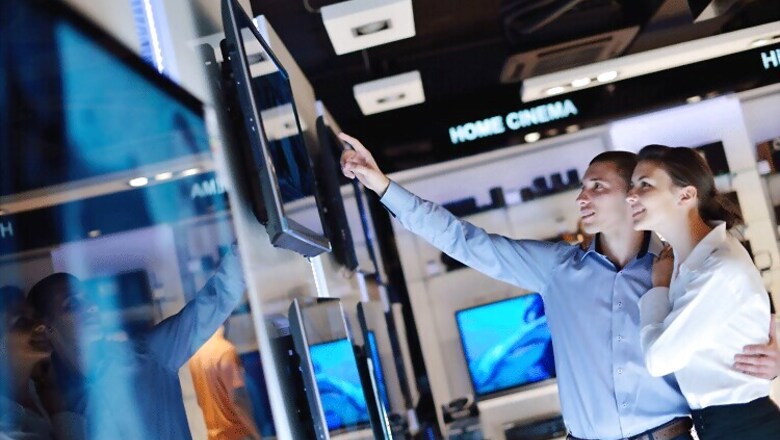
views
Los Angeles: If you're shopping for a TV, get out a tape measure and do some quick calculations before you head to the store. And count the number of gadgets you'll want to connect to your screen.
Buying a TV is no longer just choosing how big a screen you want.
Here are some big decisions you'll face:
1. HD OR 4K?
There's an emerging picture standard that offers four times the pixels of today's high definition. It's known as ultra-high definition, or 4K. But do you need it?
Measure the distance between your couch and the spot for your new TV. If you're sitting far away, a regular HD set will be just fine — for $100 to $200 less.
The farther away you sit, the less the extra pixels matter, as your eyes won't notice the difference. Conversely, the bigger the screen you have, the worse the resolution will be, and you'll notice that more when you're closer up.
How good is good enough?
A rough rule of thumb: You should sit back a little more than 1.5 times the diagonal length of the screen for TVs with full HD, also known as 1080p. So if a screen is 48 inches, or 4 feet, that's 6 feet back. For 4K, it's one to one, or 4 feet for that same screen. If your couch is 7 feet back, having 4K isn't worth it because you won't be able to tell the difference anyway. But it might if your couch is 4 or 5 feet back.
The calculation isn't that easy, but we've created an online tool to help you.
Also consider how little 4K content there is. A few streaming services, including Netflix, Amazon and M-Go, offer some 4K content, and a standard for 4K Blu-ray discs is coming together this year. But 4K broadcasts are potentially years away. Buying a 4K TV now is mostly about being ready for the future.
You also have to consider whether you'll be sitting so close to a big screen that you'll have to move your head to look left or right. Jim Willcox, senior editor at Consumer Reports, says the ideal viewing width is about 30 to 40 degrees. Our online tool will warn you if you are too close and might want a smaller screen instead.
2. HDMI PORTS
The more the merrier. TVs will have at least two, but I recommend three or four. If you pay for cable or satellite TV, you'll need one for your set-top box, then one more for a streaming device or Blu-ray player. If you want to add a game console or sound bar, you see how quickly they can fill up.
Switches that let you connect multiple HDMI devices sell for $9 to $30, but that could mean another remote control to fiddle with, or getting up to press a button. Better to get extra ports with your TV.
3. SMART TV/WIFI
Many TVs come with WiFi connectivity and apps from major services like Netflix and Hulu. Using this for streaming will save you an HDMI port.
But stand-alone streaming devices have more features. If voice control is your thing, for instance, go for more ports to plug in your Apple TV, Amazon Fire TV or other device. Some TVs have voice control, but Apple's Siri will be better at recognizing your voice because it gets fine-tuned through millions of interactions on smartphones.
If you plan to use a smart TV for streaming, consider the type of WiFi it comes with. The best right now is 802.11ac, which can deliver several gigabits per second of data. You'll want the best, especially for 4K video.
4. REFRESH RATE
Manufacturers fudge how fast images are refreshed on screen with technologies called "AquoMotion" or "Motionflow" that show "effective" refresh rates. These help smooth out fast-action scenes that might otherwise look stuttered or blurry. It's largely a matter of taste and personal sensitivity.
The minimum native refresh rate you'll see these days is 60 frames per second, or 60Hz. The most is around 120 Hz.
Steve Kindig, senior editor at electronics retailer Crutchfield.com, says that even though 60 frames per second is the highest that will come from Blu-ray discs or video games, higher rates on a TV will still cut down on blur. Either the TV's processor will interpolate frames between each actual frame, or the backlight will blink, reducing the stutter.
He says to play down effective refresh rates that are wildly higher than the native, though "it's not totally bunk because they are doing something."
Consumer Reports rates specific models with blur tests, but doesn't generalize about brands or numbers.
5. OTHER SCREEN FEATURES
Curved screens just look cool sitting on a stand, and some people say it cuts down on reflective glare, according to Kindig. They're about $200 more than non-curved screens and mostly made by Samsung. But he says they don't look good mounted on a wall.
Organic light-emitting diode screens are pricey, but will give you true blacks and better color representation because each pixel illuminates on its own. Regular, LCD screens require a backlight, which can wash out the colors a bit. If you're willing to pay for OLED, you'll likely get every other goodie thrown in besides 4K.
More expensive sets might also offer 3-D. "Active" glasses require batteries, which add to the weight and trouble of wearing them, but will offer better resolution. "Passive" glasses, like the ones you get in movie theaters, will suffice for those few times you want to settle in for a 3-D movie, likely on disc. Content is still limited.














Comments
0 comment